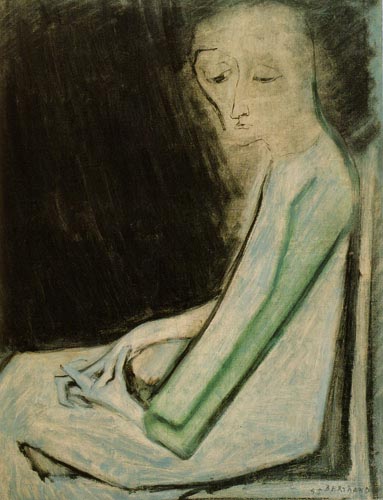Figure de femme
aux mains jointes
(Woman with joined hands)

1945, oil painting on canvas, 100 x 77 cm
Coll. Gaston Bertrand Foundation
N ° inv. 152
Bertrand’s work became increasingly austere after 1945, which marked the beginning of the Young Belgian Painting adventure. Gaston Bertrand temporarily used a very neutral palette, exclusively dominated by black, grey and white colours. The artist justified his radical position by the need to focus his researches on the shape, as shown in the two masterful effigies produced in 1945: on the one hand, Portrait de ma mère offers a striking expression, close to caricature and yet so pathetic; and on the other hand, Figure de femme aux mains jointes represents a woman contrasting with the abstract monochrome background and the brush strokes’ movements. The latter is a well-known painting that still amazes by the daring expression of the schematized face and arms, even more striking given that the portrayed woman is the artist’s mother.
In the face of such daring physical distortions, it seems appropriate to classify Bertrand’s work in the Expressionist movement. However, this type of Expressionism is not related to Permeke, although Bertrand admired him, but rather to the more ghostly expressionism characterizing Picasso’s works in the 1900s and that the young Belgian artists discovered with great interest at the time. As noted by Francine-Claire Legrand regarding this type of expressionist schematization: “in this context, caricature originates from the anxious feelings of a speculative character, wishing to dematerialize the world, to capture its very essence rather than its substance, a character which is very far from the Flemish tranquil sensuality”.